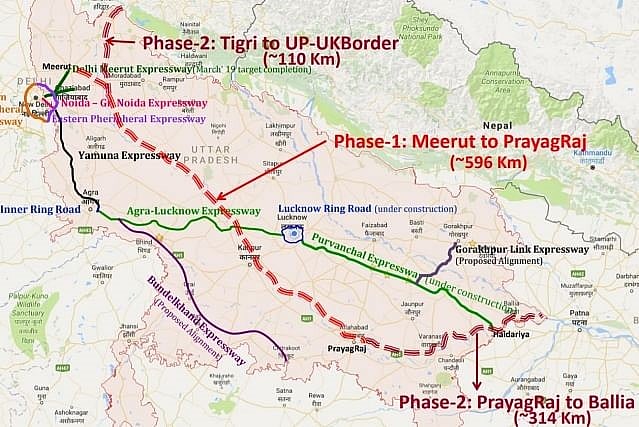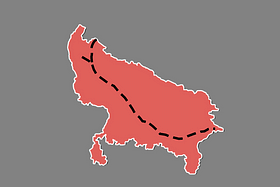Snapshot
-
With four expressways already operational in Uttar Pradesh, the Ganga Expressway, will complete the expressway grid in the state.
The expressway is expected to reduce travel time between Delhi and Prayagraj from the current 10-11 hours to just 6-7 hours.
The preparatory work on the Ganga Expressway in Uttar Pradesh is gaining pace, with clearing and grubbing work done on 500 km out of the total 593.94 km, as on 27 December.
According to the daily progress report made available by the Uttar Pradesh Expressways Industrial Development Authority (UPEIDA), 84.11 per cent CG work and 7.3 per cent earthwork has been completed on the expressway.
Preparing the construction area is referred to as clearing and grubbing. During the clearing phase, trees are felled. Grubbing refers to the clearing and removal of stumps and organic debris.
The construction of six-lane expressway which connects Meerut with Prayagraj, was inaugurated by Prime Minister Narendra Modi in Shahjahanpur, Uttar Pradesh on 18 December 2021.
The ambitious project to build an expressway connecting eastern and western parts of Uttar Pradesh has been in the pipeline since 2007 and was revived in 2019.
Alignment
The six-lane (expandable to eight lane) expressway starts from NH-334 near the Bijauli village in Meerut district and terminates at Prayagraj Bypass on NH-19, near Judapur Dandu village in Prayagraj.
Traversing through 12 districts — Meerut, Hapur, Bulandshahr, Amroha, Sambhal, Badaun, Shahjahanpur, Hardoi, Unnao, Rae Bareilly, Pratapgarh and Prayagraj — the fully access controlled expressway would connect the eastern and western parts of the state.

The state government has plans to extend the expressway at both ends — by 110 km from Meerut to Tigri on the Uttar Pradesh/Uttarakhand border and by 314 km from Prayagraj to Ballia, in the second phase of the project.
Two Contractors
Phase-1 of Ganga Expressway has been divided into 12 civil packages. In March 2021, UPEIDA invited tenders for the expressway’s development through four groups each consisting of three packages.
On 30 November, IRB Infrastructure Developers and Adani Enterprises Ltd (AEL), emerged as the preferred bidders for the expressway’s development. IRB bagged Group-I consisting of Packages 1-3, while Adani bagged Groups II-IV consisting of Packages 4-12.

Meerut Budaun Expressway Private Ltd, a Special purpose vehicle (SPV) and the wholly-owned subsidiary of IRB Infra will develop the 129.70 km stretch from Meerut to Badaun under Group-I.
Similarly, Adani Enterprises through its three wholly owned subsidiaries — Budaun Hardoi Road Private Ltd (BHRPL), Hardoi Unnao Road Private Ltd (HURPL) and Unnao Prayagraj Road Private Ltd (UPRPL) — will develop Group-II, III and IV respectively.
The three groups totalling 464 km from Budaun to Prayagraj, comprises 80 per cent of the expressway project.
DBFOT Model
The Ganga Expressway is being executed by UPEIDA on DBFOT (Toll) basis under public private partnership (PPP) mode.
Design-build-finance-operate-transfer (DBFOT) contract is where the private sector designs, finances and constructs a new facility under a long-term lease, and operates the facility during the term of the lease.
The facility is transferred back to the public entity at the end of the lease term.
The greenfield project has a 30 year concession period (further extendable by 6 years based on traffic) commencing from the appointed date, including construction period of 3 years.
The choice of DBFOT model is primarily due to huge financial outlay involved and is in contrast to the Purvanchal Expressway and Bundelkhand expressways, which have been built under the engineering-procurement-construction (EPC) mode, in which the entire cost was borne by the state government.
Financial Progress
All four groups in the greenfield project have been financially closed. The project is being financed through a combination of grant by the UPEIDA, external borrowing and equity infusion by the company.
Selection of bidders for four groups has been done on the basis of the lowest grants quoted for the respective groups.
A total of Rs 7,742 crore will be provided to the developers as grants in the form of viability gap funding (VGF).
Viability Gap Funding means a grant to support projects that are economically justified but not financially viable. A comprehensive status of the financial closure of all the four groups is below.

In a PPP project, financial closure indicates the commencement of the concession period. The date on which financial closure is achieved is the appointed date which is deemed to be the date of commencement of the concession period.
Work Progress
While IRB has completed 82.7 per cent of CG work on Group-I, the Adani group has completed 85.73 per cent, 85.77 per cent and 82.07 per cent CG work on Group II, III and IV respectively.
Below is a status tracker of the project as on 27 December.
With land acquisition completed, the actual construction work on the project is expected to start next year and will take 36 months to complete.
What to Expect
Four expressways — Yamuna, Agra-Lucknow, Purvanchal and Bundelkhand — are already operational in Uttar Pradesh. Once complete, the Ganga Expressway, will complete the expressway grid in the state. All the expressways are interlinked.
The project will provide direct high-speed connectivity from the National Capital Region to Meerut and then onwards to Prayagraj. On becoming operational, the expressway is expected to reduce travel time between Delhi and Prayagraj from the current 10-11 hours to just 6-7 hours.
Being the largest expressway planned in the state, the Ganga expressway is expected to play a key role in Chief Minister Yogi Adityanath’s plan to make Uttar Pradesh into a USD one trillion economy state.


